Vibration Response of the Interfaces in Multi-Layer Combined Coal and Rock Mass under Impact Load
Abstract
:1. Introduction
2. Experimental Design
2.1. Experimental Model
2.2. Action Points and Sensors Distribution
2.3. Experimental Process
3. Experimental Results
3.1. Amplitude Variation of Interface Vibration under Impact Load
3.1.1. Amplitude Variation of Interface Vibration under Single Point Excitation
3.1.2. Amplitude Variation of Interface Vibration under Multi-Point Excitation
3.2. Amplitude Attenuation Law of Interface Vibration under Impact Load
3.2.1. Dynamic Attenuation Law of Amplitude under Single Point Excitation
3.2.2. Dynamic Attenuation Law of Amplitude under Multi-Point Excitation
4. Amplitude-Frequency Distribution of Interface Vibration under Impact Load
4.1. Amplitude-Frequency Distribution of Interface Vibration under Single Point Excitation
4.2. Amplitude-Frequency Distribution under Multi-Point Excitation Step-by-Step
4.3. Amplitude-Frequency Distribution under Multi-Point Synchronous Excitation
5. Effective Vibration Modes and Predominant Frequency of Interface Vibration under Impact Load
6. Conclusions
Author Contributions
Funding
Data Availability Statement
Conflicts of Interest
Abbreviations
| EEMD | Ensemble Empirical Mode Decomposition |
| FFT | Fast Fourier transform |
| HHT | Hilbert Huang transform |
| IMF | Intrinsic Mode Functions |
References
- Xu, D.P.; Feng, X.T.; Chen, D.F.; Zhang, C.Q.; Fan, Q.X. Constitutive representation and damage degree index for the layered rock mass excavation response in underground openings. Tunn. Undergr. Space Technol. 2017, 64, 133–145. [Google Scholar] [CrossRef]
- Wang, P.T.; Cai, M.F.; Ren, F.H. Anisotropy and directionality of tensile behaviours of a jointed rock mass subjected to numerical Brazilian tests. Tunn. Undergr. Space Technol. 2018, 64, 133–145. [Google Scholar] [CrossRef]
- Liu, Y.S.; He, C.S.; Fu, H.L.; Wang, S.M.; Lei, Y.; Peng, Y.X. Study on dynamic and static mechanical properties and failure mode of layered slate. J. Railw. Sci. Eng. 2020, 17, 2789–2797. [Google Scholar] [CrossRef]
- Wu, G.P.; Shen, W.W.; Cui, K.; Wang, P. Degradation behavior and mechanism of slate under alternating conditions of freeze-thaw and wet-dry. J. Cent. South Univ. (Sci. Technol.) 2019, 50, 92–1402. [Google Scholar] [CrossRef]
- Liu, Y.S.; Wang, S.M.; Yan, S.J.; Fu, H.L.; Chen, C.; Shi, Y.; Yue, J. Properties and failure mechanism of layered sandstone based on acoustic emission experiments. J. Cent. South Univ. (Sci. Technol.) 2019, 50, 1419–1427. [Google Scholar] [CrossRef]
- Zhou, P.F.; Shen, Y.S.; Zhao, J.F.; Zhang, X.; Gao, B.; Zhu, S.Y. Research on disaster-induced mechanism of tunnels with steeply dipping phyllite strata based on an improved ubiquitous-joint constitutive model. Chin. J. Rock Mech. Eng. 2019, 38, 1870–1883. [Google Scholar] [CrossRef]
- Su, G.S.; Hu, L.H.; Feng, X.T.; Wang, J.H.; Zhang, X.H. True triaxial experimental study of rockburst process under low frequency cyclic disturbance load combined with static load. Chin. J. Rock Mech. Eng. 2016, 35, 1309–1322. [Google Scholar] [CrossRef]
- Chang, W.B.; Fan, S.W.; Zhang, L.; Shu, L.Y. A model based on explosive stress wave and tectonic coal zone which gestate dangerous state of coal and gas outburst. J. China Coal Soc. 2014, 39, 2226–2231. [Google Scholar] [CrossRef]
- Zuo, J.P.; Chen, Y.; Cui, F. Investigation on mechanical properties and rock burst tendency of different coal-rock combined bodies. J. China Univ. Min. Technol. 2018, 47, 81–87. [Google Scholar] [CrossRef]
- Li, S.H.; Zhu, W.C.; Niu, L.L.; Yu, M.; Chen, C.F. Dynamic characteristics of green sandstone subjected to repetitive impact loading: Phenomena and mechanisms. Rock Mech. Rock Eng. 2018, 51, 1921–1936. [Google Scholar] [CrossRef]
- Mu, Z.L.; Wang, H.; Peng, P.; Liu, Z.J.; Yang, X.C. Experimental research on failure characteristics and bursting liability of rock-coal-rock sample. J. Min. Saf. Eng. 2013, 30, 841–847. [Google Scholar]
- Liu, S.H.; Qin, Z.H.; Lou, J.F. Experimental study of dynamic failure characteristics of coal-rock compound under one-dimensional static and dynamic loads. Chin. J. Rock Mech. Eng. 2014, 33, 2064–2075. [Google Scholar] [CrossRef]
- Potvin, Y.; Hadjigeorgiou, J.; Stacey, D. Challenges in Deep and High Stress Mining; Australian Center for Geomechanics: Nedlands, Australia, 2007. [Google Scholar]
- Hoke, E. Progressive caving induced by mining an inclined orebody. Trans. Inst. Min. Metall. 1974, 83, 133–139. [Google Scholar]
- Braunagel, M.J.; Griffith, W.A. The effect of dynamic stress cycling on the compressive strength of rocks. Geophys. Res. Lett. 2019, 46, 6479–6486. [Google Scholar] [CrossRef]
- Cui, F.; Yang, Y.B.; Lai, X.P.; Cao, J.T. Similar material simulation experimental study on rockbursts induced by key stratum breaking based on microseismic monitoring. Chin. J. Rock Mech. Eng. 2019, 38, 803–814. [Google Scholar] [CrossRef]
- Li, F.; Dong, X.H.; Wang, Y.; Liu, H.W.; Chen, C.; Zhao, X. The Dynamic Response and Failure Model of Thin Plate Rock Mass under Impact Load. Shock. Vib. 2021, 2021, 9998558. [Google Scholar] [CrossRef]
- Yang, S.L.; Wang, J.C.; Yang, J.H. Physical analog simulation analysis and its mechanical explanation on dynamic load impact. J. China Coal Soc. 2017, 42, 335–343. [Google Scholar] [CrossRef]
- Song, X.L.; Gao, W.X.; Ji, J.M.; Ye, M.B.; Zhang, D.J. Blasting damage analysis method based on EEMD-HHT transform. J. Cent. South Univ. (Sci. Technol.) 2017, 42, 335–343. [Google Scholar] [CrossRef]
- Zhao, Y.; Shan, R.L.; Wang, H.L. Research on vibration effect of tunnel blasting based on an improved Hilbert–Huang transform. Environ. Earth Sci. 2021, 80, 206. [Google Scholar] [CrossRef]
- Hamdi, S.E.; Le, D.A.; Simon, L.; Plantier, G.; Sourice, A.; Feuilloy, M. Acoustic emission pattern recognition approach based on Hilbert–Huang transform for structural health monitoring in polymer-composite materials. Appl. Acoust. 2013, 74, 746–757. [Google Scholar] [CrossRef]
- Liu, X.; Wang, J.; Li, W. A time-frequency extraction model of structural vibration combining VMD and HHT. Geomat. Inf. Sci. Wuhan Univ. 2021, 46, 1686–1692. [Google Scholar] [CrossRef]
- Dragomiretskiy, K.; Zosso, D. Variational Mode Decomposition. IEEE Trans. Signal Process. 2014, 62, 531–544. [Google Scholar] [CrossRef]
- Lu, C.P.; Dou, L.M.; Wu, X.R.; Mou, Z.L.; Chen, G.X. Experimental and Empirical Research on Frequency-Spectrum Evolvement Rule of Rockburst Precursory Microseismic Signals of Coal-Rock. Chin. J. Rock Mech. Eng. 2008, 27, 519–525. [Google Scholar] [CrossRef]
- Zhang, P.S.; Liu, S.D. The Structure Character of Coal and Rock by Seismic Wave Spectrum Analyzing Technology and Its Application. Chin. J. Eng. Geophys. 2006, 3, 274–277. [Google Scholar] [CrossRef]


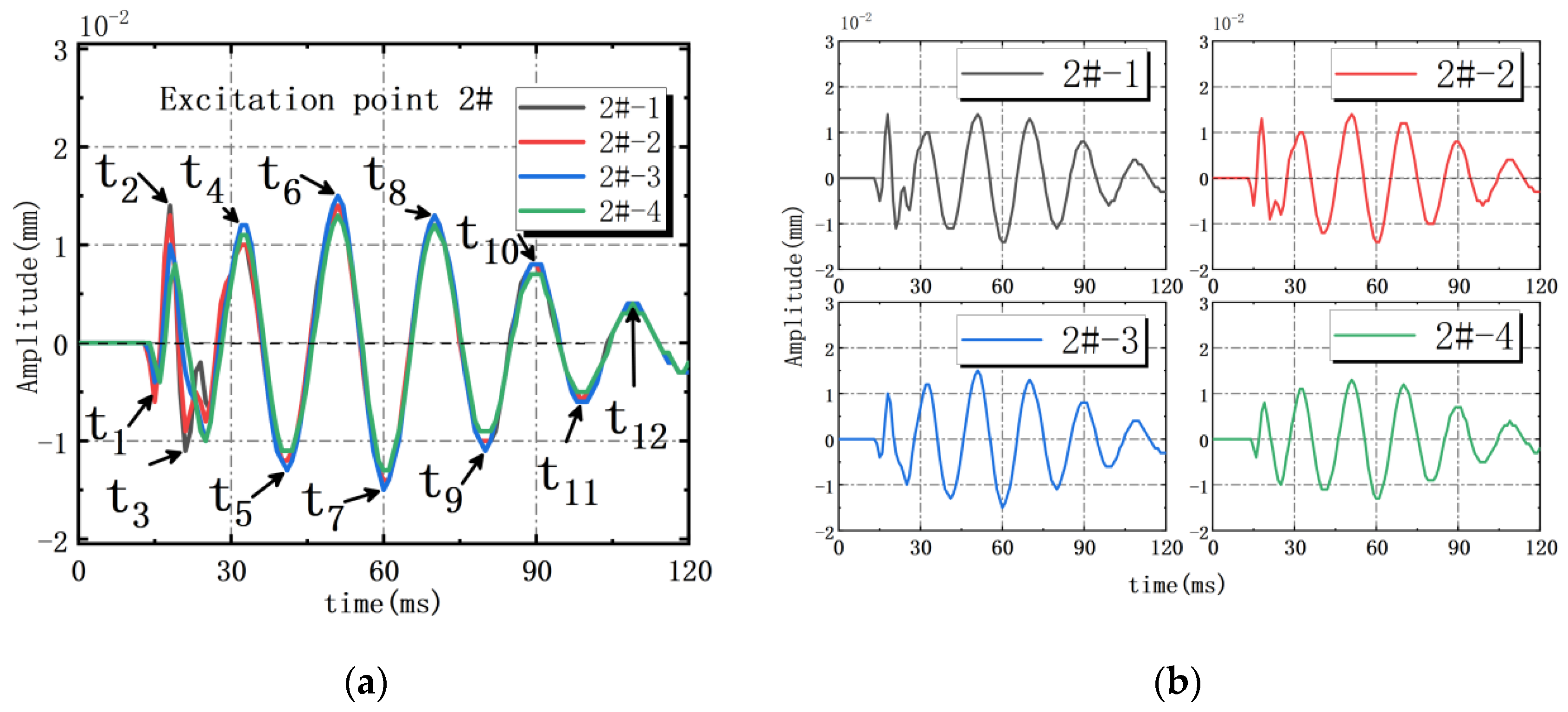
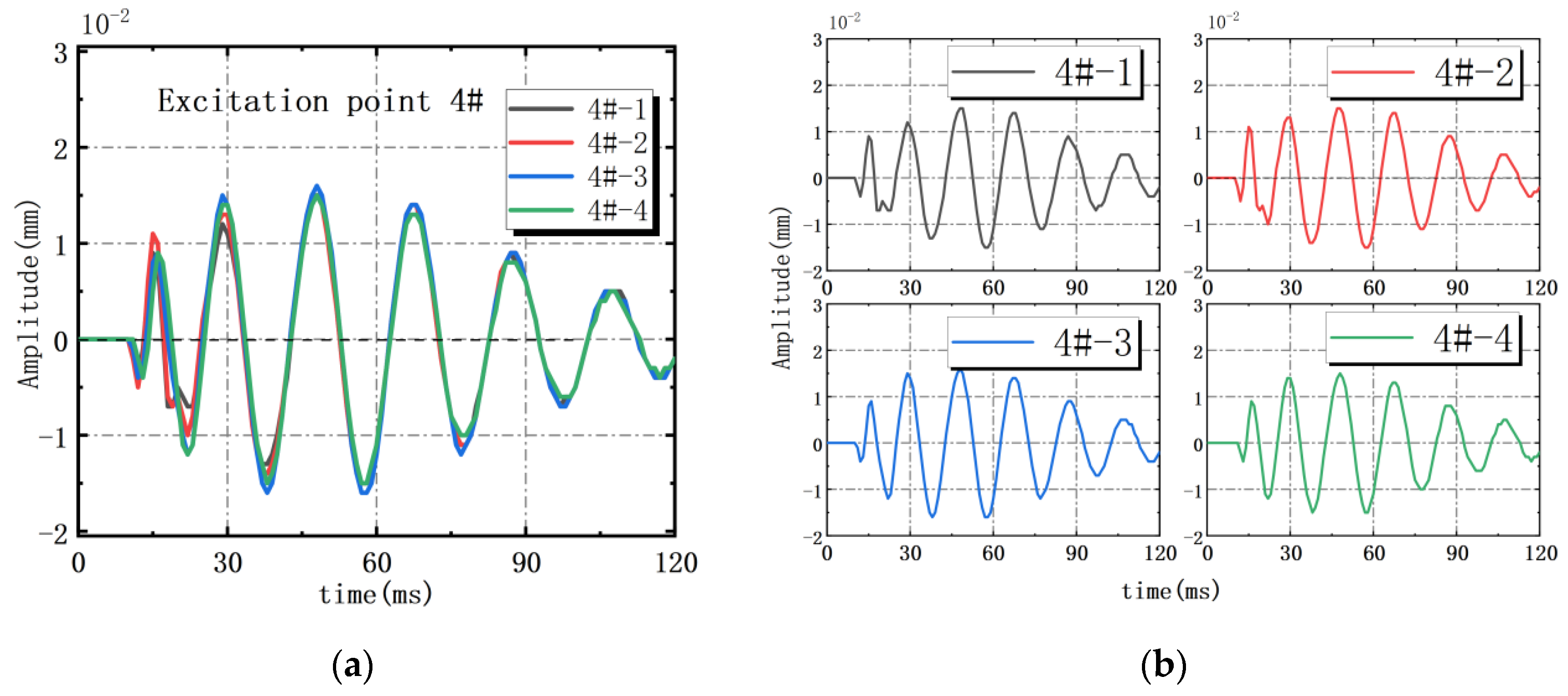
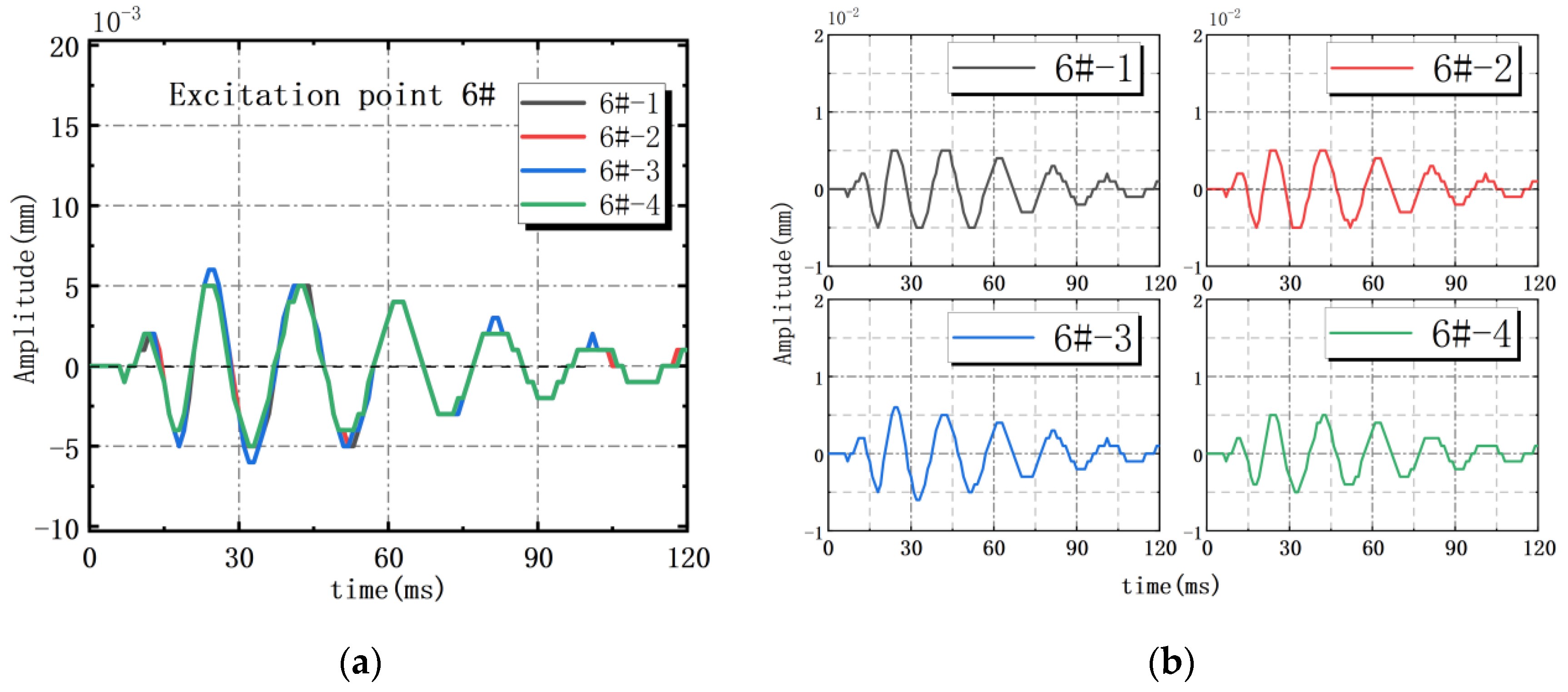
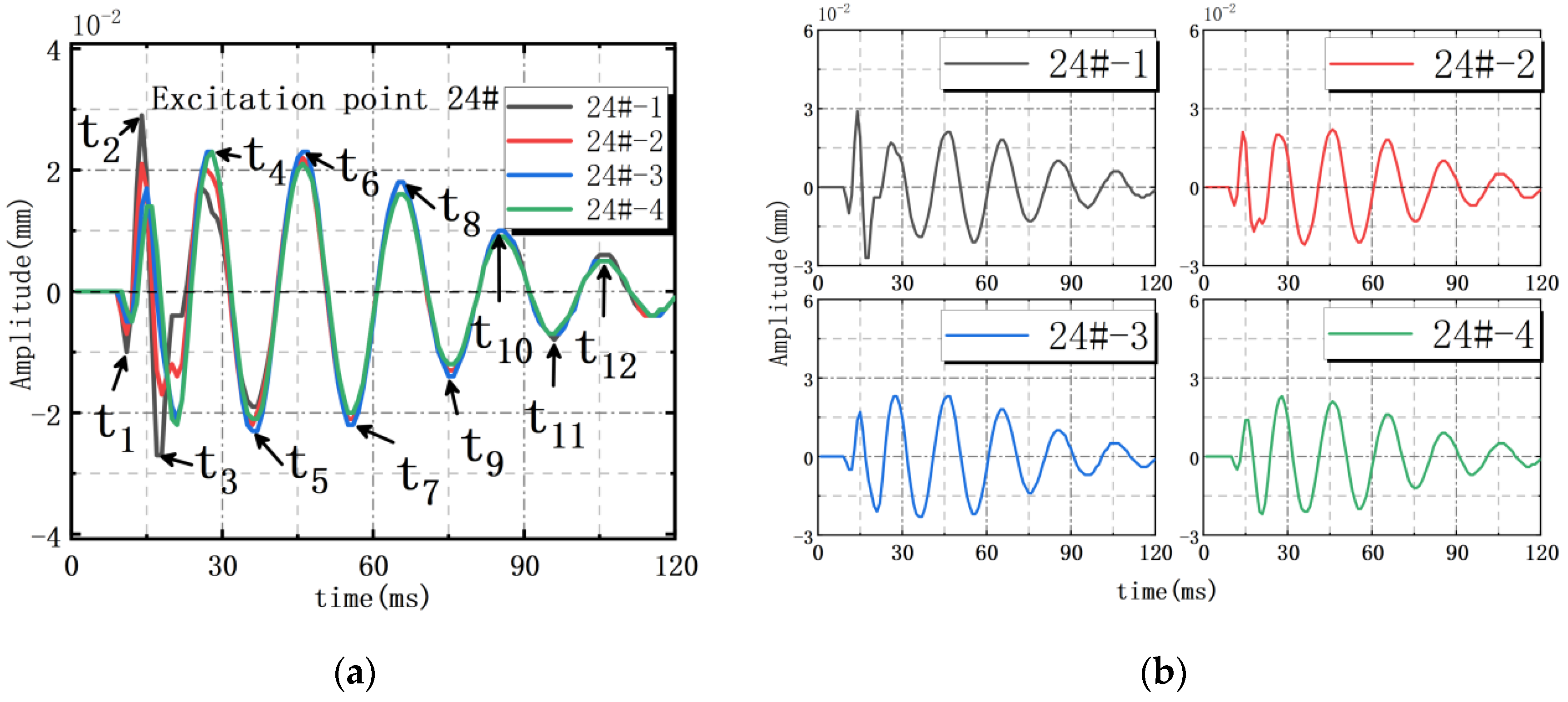
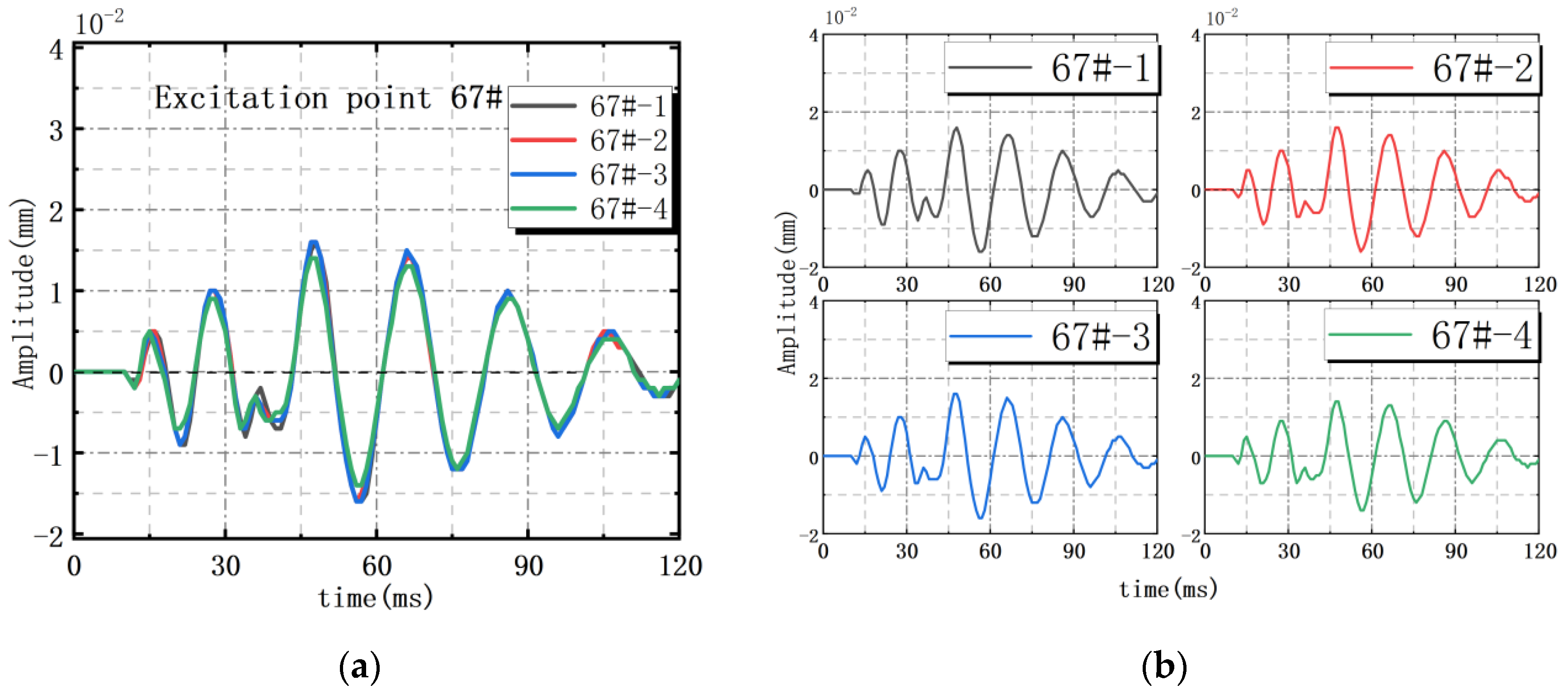
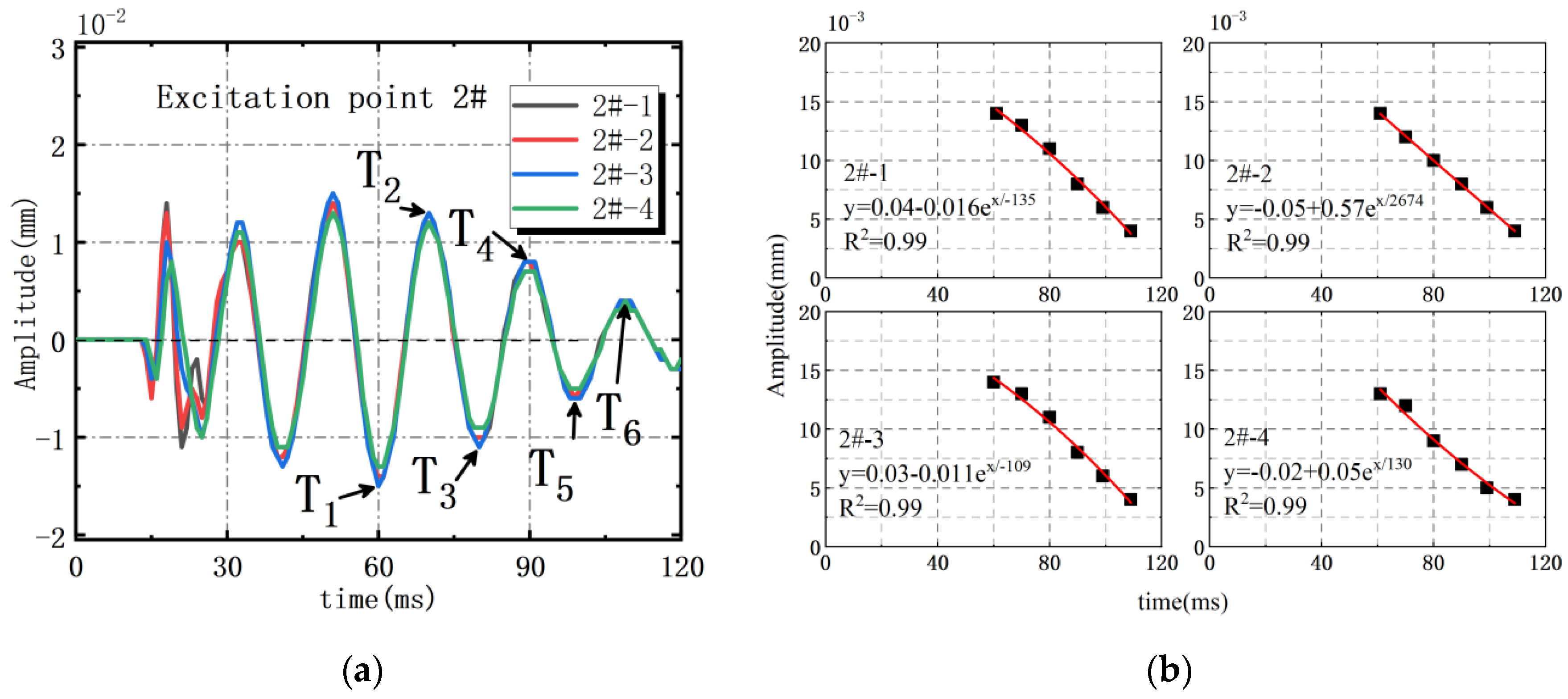
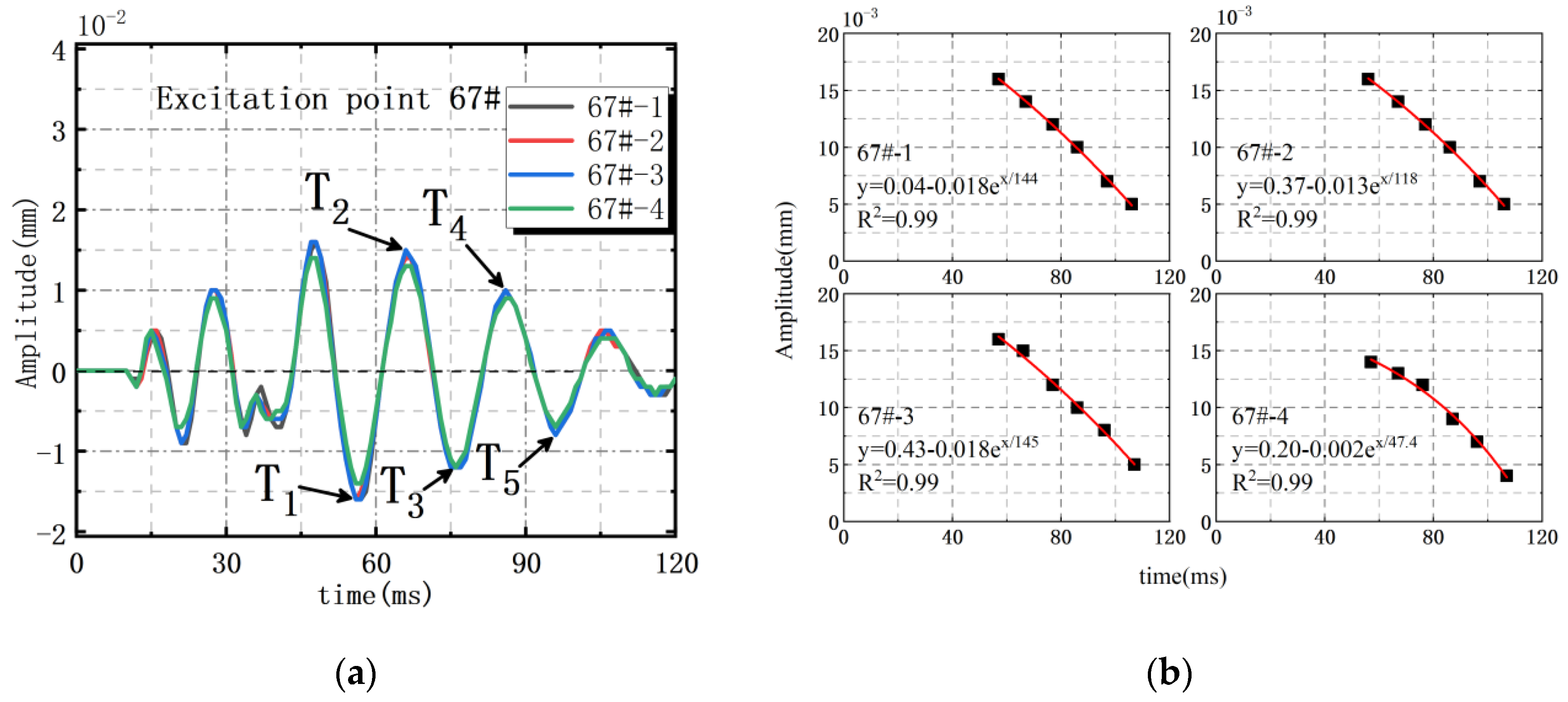

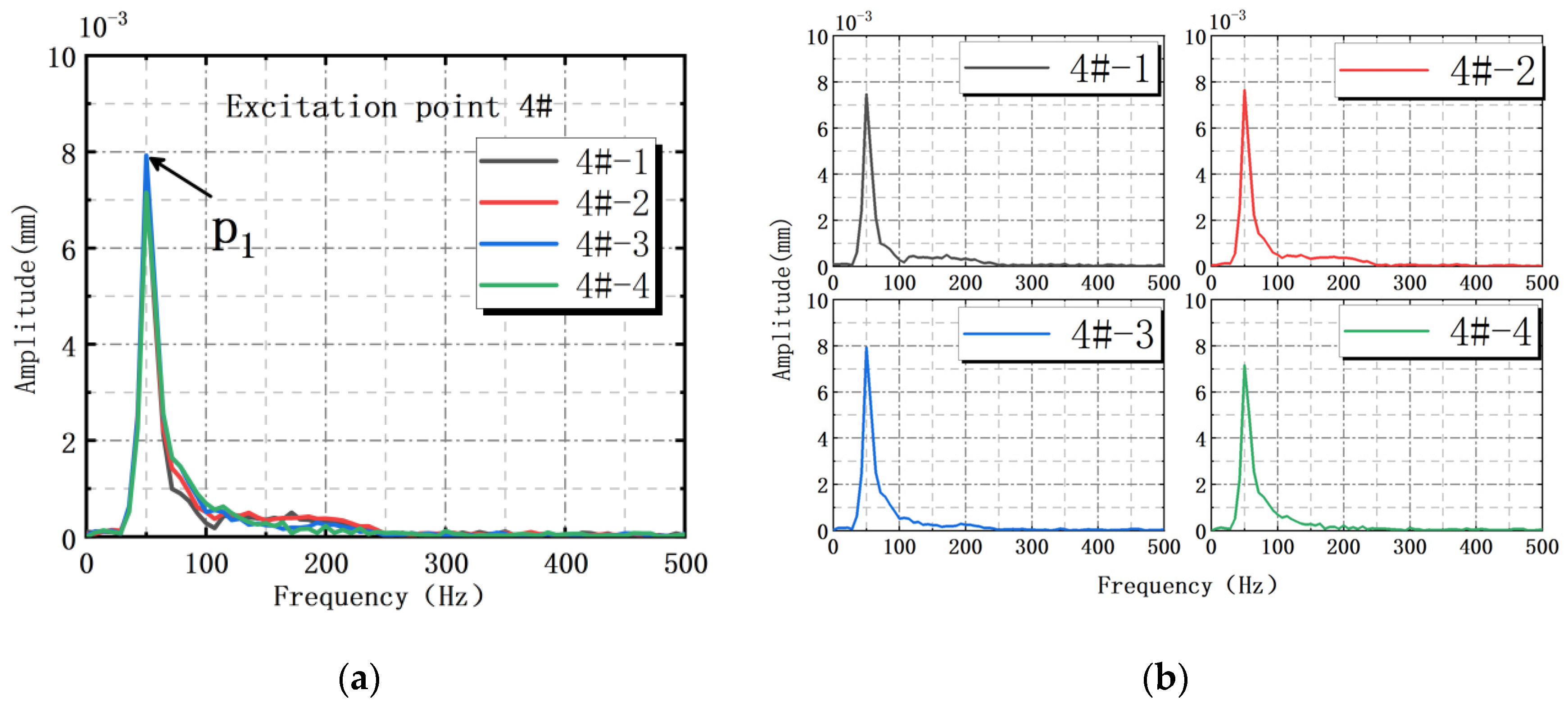
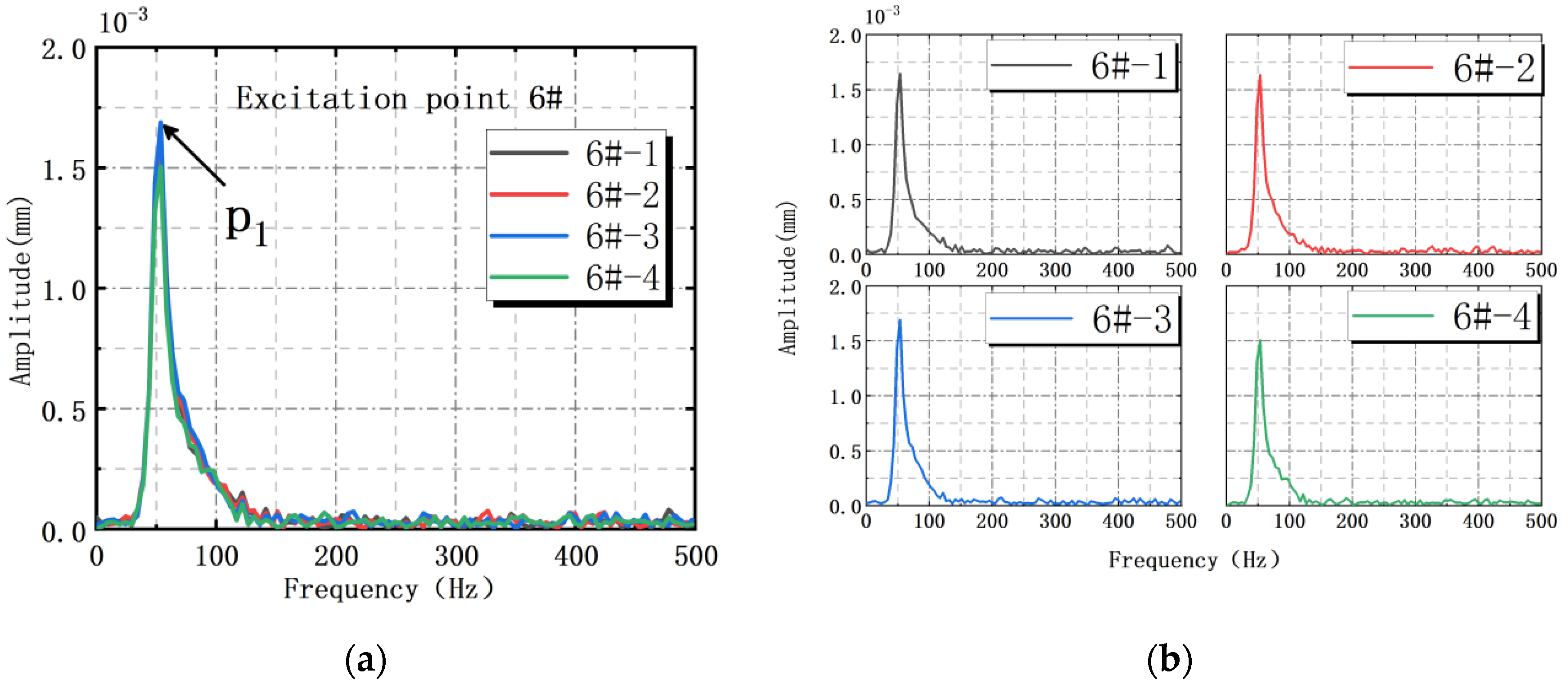

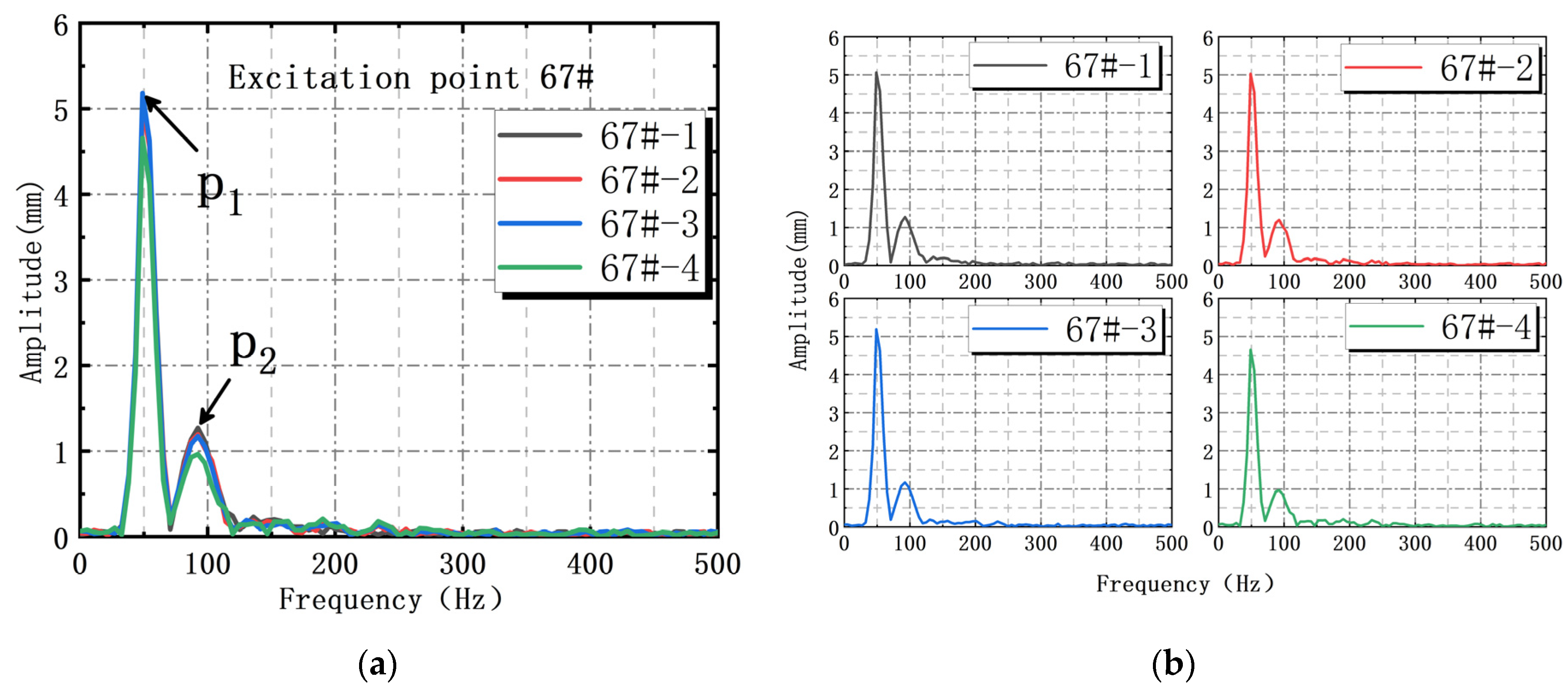

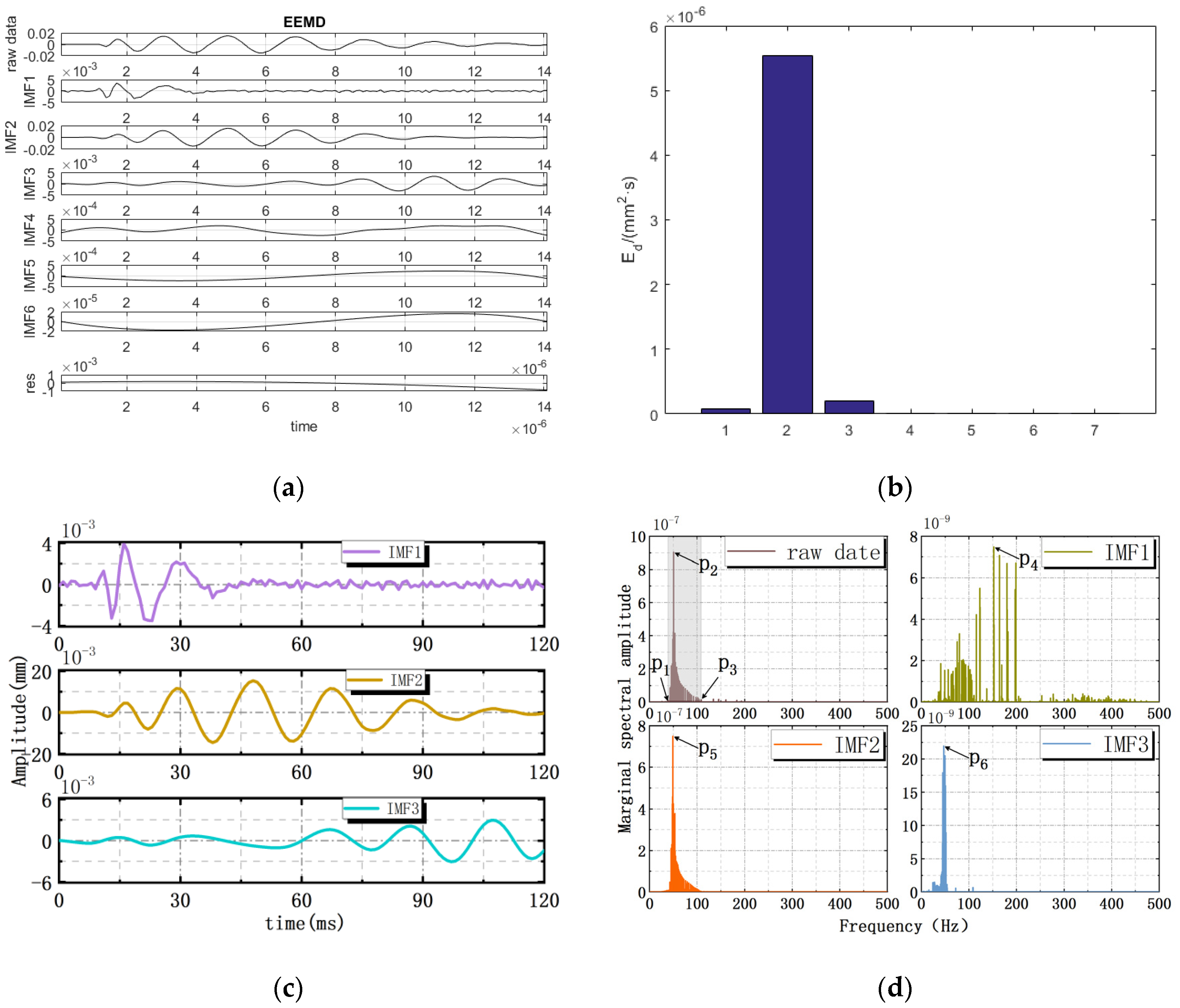
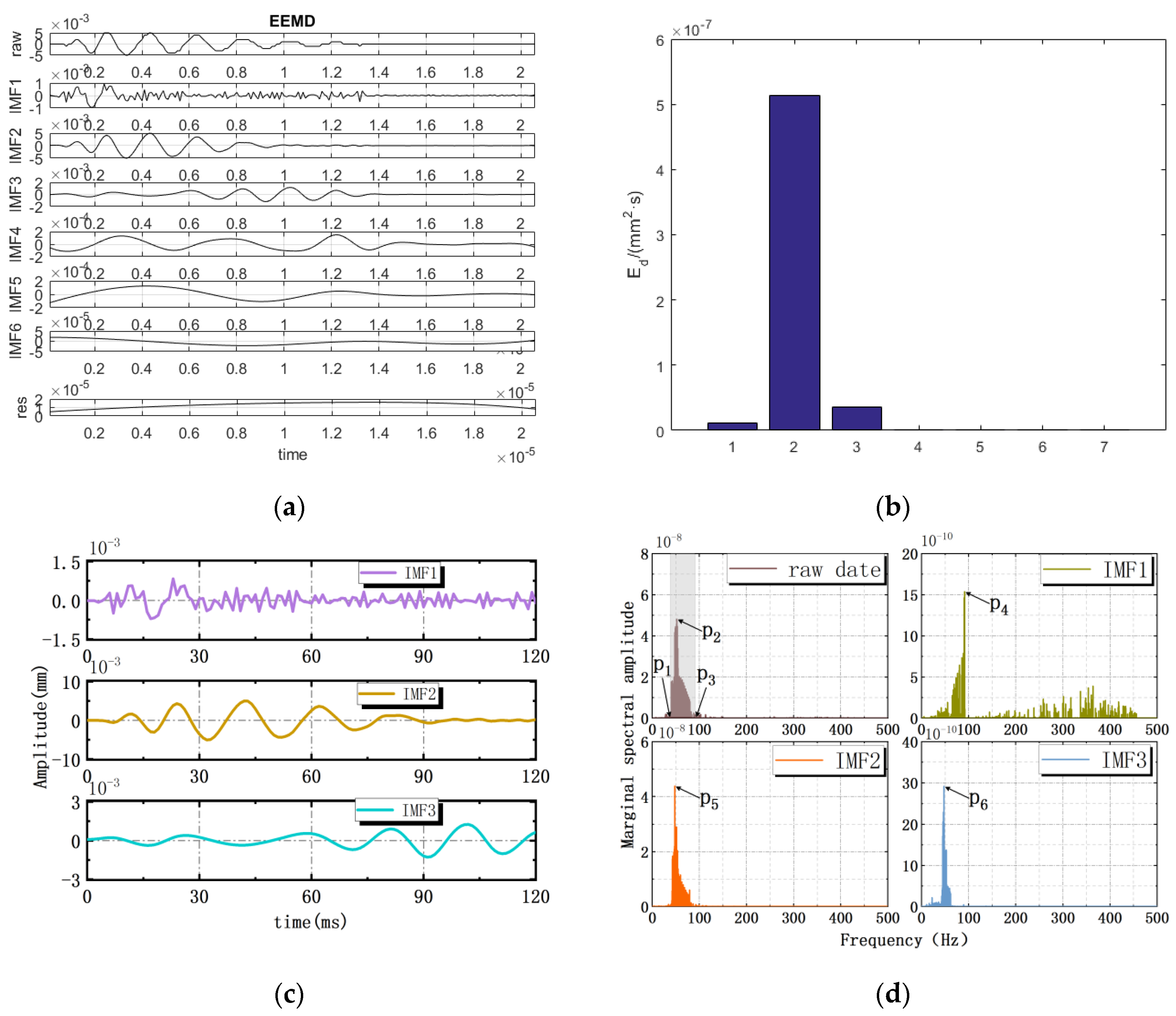


| Serial Number | Layers of Coal and Rock Mass | Raw Material Compressive Strength (MPa) | Similar Material Compressive Strength (MPa) | Fine Sand (Kg) | Cement (Kg) | Gypsum (Kg) | Water (Kg) |
|---|---|---|---|---|---|---|---|
| 1 | Fine sandstone | 120 | 0.75 | 72.98 | 7.30 | 17.03 | 9.73 |
| 2 | Medium sandstone | 80.1 | 0.50 | 81.09 | 8.11 | 8.11 | 9.73 |
| 3 | Coal | 10 | 0.063 | 86.49 | 7.57 | 3.24 | 9.73 |
| 4 | Coarse sandstone | 61.5 | 0.384 | 83.40 | 6.95 | 6.95 | 9.73 |
| 5 | Mudstone | 27.4 | 0.171 | 88.46 | 6.32 | 6.32 | 10.11 |
| Extreme Value (mm)/Time (ms) | 2# | 4# | 6# |
|---|---|---|---|
| s1/t1 | 0.005/15 | 0.004/12 | 0.001/7 |
| s2/t2 | 0.014/18 | 0.009/15 | 0.002/13 |
| s3/t3 | 0.011/21 | 0.007/22 | 0.005/18 |
| s4/t4 | 0.010/33 | 0.012/29 | 0.005/25 |
| s5/t5 | 0.011/42 | 0.013/38 | 0.005/33 |
| s6/t6 | 0.014/51 | 0.015/49 | 0.005/43 |
| s7/t7 | 0.014/61 | 0.015/58 | 0.005/52 |
| s8/t8 | 0.013/70 | 0.014/67 | 0.004/62 |
| s9/t9 | 0.011/80 | 0.011/78 | 0.003/72 |
| s10/t10 | 0.008/90 | 0.008/86 | 0.003/82 |
| s11/t11 | 0.006/99 | 0.007/97 | 0.002/92 |
| s12/t12 | 0.004/109 | 0.004/117 | 0.002/101 |
| Extreme Value (mm)/Time (ms) | 2# and 4# | 6# and 7# |
|---|---|---|
| s1/t1 | 0.010/11 | 0.001/12 |
| s2/t2 | 0.029/14 | 0.004/17 |
| s3/t3 | 0.027/18 | 0.009/22 |
| s4/t4 | 0.016/27 | 0.010/28 |
| s5/t5 | 0.019/37 | 0.008/34 |
| s6/t6 | 0.021/47 | 0.016/48 |
| s7/t7 | 0.021/56 | 0.016/57 |
| s8/t8 | 0.018/66 | 0.014/67 |
| s9/t9 | 0.013/76 | 0.012/77 |
| s10/t10 | 0.010/86 | 0.010/86 |
| s11/t11 | 0.008/96 | 0.007/97 |
| s12/t12 | 0.006/107 | 0.005/106 |
| Extreme Point | Time (ms) | No. 1 (mm) | Time (ms) | No. 2 (mm) | Time (ms) | No. 3 (mm) | Time (ms) |
|---|---|---|---|---|---|---|---|
| T1 | 61 | 0.014 | 61 | 0.014 | 60 | 0.014 | 61 |
| T2 | 70 | 0.013 | 70 | 0.012 | 70 | 0.013 | 70 |
| T3 | 80 | 0.011 | 80 | 0.01 | 80 | 0.011 | 80 |
| T4 | 90 | 0.008 | 90 | 0.008 | 90 | 0.008 | 90 |
| T5 | 99 | 0.006 | 99 | 0.006 | 99 | 0.006 | 99 |
| Extreme Point | Time (ms) | No. 1 (mm) | Time (ms) | No. 2 (mm) | Time (ms) | No. 3 (mm) | Time (ms) |
|---|---|---|---|---|---|---|---|
| T1 | 57 | 0.016 | 56 | 0.016 | 57 | 0.016 | 57 |
| T2 | 67 | 0.014 | 67 | 0.014 | 66 | 0.015 | 67 |
| T3 | 77 | 0.012 | 77 | 0.012 | 77 | 0.012 | 76 |
| T4 | 86 | 0.01 | 86 | 0.01 | 86 | 0.01 | 87 |
| T5 | 97 | 0.007 | 97 | 0.007 | 96 | 0.008 | 96 |
Disclaimer/Publisher’s Note: The statements, opinions and data contained in all publications are solely those of the individual author(s) and contributor(s) and not of MDPI and/or the editor(s). MDPI and/or the editor(s) disclaim responsibility for any injury to people or property resulting from any ideas, methods, instructions or products referred to in the content. |
© 2023 by the authors. Licensee MDPI, Basel, Switzerland. This article is an open access article distributed under the terms and conditions of the Creative Commons Attribution (CC BY) license (https://creativecommons.org/licenses/by/4.0/).
Share and Cite
Li, F.; Wang, G.; Xiang, G.; Tang, J.; Ren, B.; Chen, Z. Vibration Response of the Interfaces in Multi-Layer Combined Coal and Rock Mass under Impact Load. Processes 2023, 11, 306. https://doi.org/10.3390/pr11020306
Li F, Wang G, Xiang G, Tang J, Ren B, Chen Z. Vibration Response of the Interfaces in Multi-Layer Combined Coal and Rock Mass under Impact Load. Processes. 2023; 11(2):306. https://doi.org/10.3390/pr11020306
Chicago/Turabian StyleLi, Feng, Guanghao Wang, Guangyou Xiang, Jia Tang, Baorui Ren, and Zhibang Chen. 2023. "Vibration Response of the Interfaces in Multi-Layer Combined Coal and Rock Mass under Impact Load" Processes 11, no. 2: 306. https://doi.org/10.3390/pr11020306




